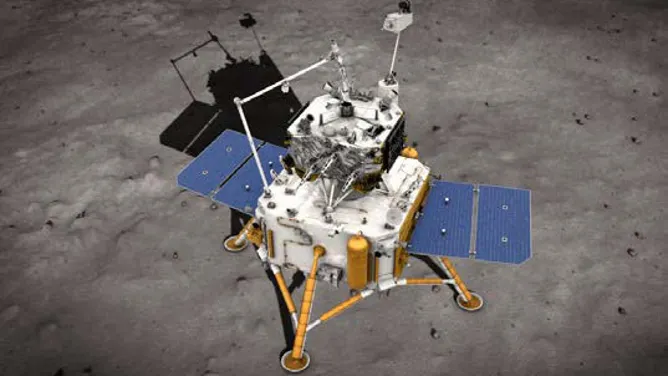Chang’e-6-China’s Spacecraft 24
Chang’e-6-China’s Spacecraft
According to Xinhua News Agency, Chang’e-6’s successful landing on the moon’s far side is another significant accomplishment for the China National Space Administration (CNSA). The goal of this mission is to gather samples from an understudied area of the moon and return them to Earth before anyone else does. With the successful landing of Chang’e-6, China’s spacecraft, China has successfully completed its second mission to the Moon’s far side, having previously conducted the historic Chang’e-4 landing in 2019.

China’s lunar exploration program, called Chang’e after the Chinese moon goddess, includes the Chang’e missions. An important advancement in space exploration and scientific study is the Chang’e-6 mission.
Scientists intend to acquire fresh knowledge about the moon’s composition, geological past, and the processes that have shaped it by collecting samples from the far side of the moon.
China is becoming more capable and ambitious in space, as seen by its continuous improvements in space technology and exploration. Not only does China’s technological superiority come through the successful landing of Chang’e-6, but it also provides important data to the international scientific community that advances our knowledge of the Moon and the solar system.
Chang’e-6 made a successful landing on the Moon’s far side, marking a historic accomplishment for the China National Space Administration (CNSA), according to Xinhua News Agency. This is the most difficult hemisphere to land on, as it is never facing Earth, which makes communication more difficult. No other nation has done so.
Chang’e-6 is expected to start subterranean drilling and extend a robotic arm to collect surface samples within 48 hours of landing.
Significant scientific potential exists at the mission’s landing site, an impact crater in the Apollo Basin, which is part of the South Pole-Aitken Basin. This area might have water ice, which could be used to create rocket fuel and oxygen, two essentials for long-term humans living on the moon.
Follow our Digiknowledge.co.in page for the latest updates about technology, bikes, cars, sports, lifestyle, and many more.
According to Huang Hao, an official of the China Aerospace Science and Technology Corporation, the Apollo Basin was selected not just for its scientific worth but also for its good circumstances for communication, telemetry, and geographical flatness.
In order to gather and return samples from the Moon’s far side and offer fresh perspectives on the Moon’s composition and geological past, China is launching the Chang’e-6 mission as part of an ambitious lunar exploration program.
With the goal of improving our knowledge of the Moon and the larger solar system and providing invaluable data to the international scientific community, this mission highlights China’s increasing capabilities and aspirations in space exploration.
The mission, which was scheduled to launch on May 6, is anticipated to last roughly 53 days.
The Chang’e-6 landing occurred a few days after Beijing and Russia agreed to work together to build the International Lunar Research Station, a permanent outpost that would be located close to the lunar south pole. The agreement was approved by the State Duma, the lower house of parliament in Russia. The deal “strengthens the strategic partnership with China, advances Russian space activities, and reinforces Russia’s leading role in space exploration, including lunar research and utilization,” according to a May 28 report from the Tass news agency.
In an effort to establish a permanent human presence on the Moon, this collaboration represents a major advancement in international space cooperation.
Where is Chang’e 6 now?
Chang’e-6 touched down within an impact crater known as the Apollo Basin, located within the sprawling, roughly 2,500-kilometer-diameter South Pole-Aitken Basin, according to Chinese state media Xinhua.
What is the latest mission of China?
If all goes as planned, by late June, scientists will be studying the first rocks from the far side of the Moon.,after after successfully launching of Chang’e 6





Awesome website
Thanks.
Pingback: Starship SpaceX Returns to Earth 24 - Digiknowledge
Thanks for your kind words.
Pingback: Chang e-6 Returns With First Far Side Moon Samples
It sounds like you appreciate well-presented and stylishly written content. Ensuring clarity and coherence in communication is essential to maintain engagement and understanding. What specific type of content or topics do you typically enjoy reading or discussing?